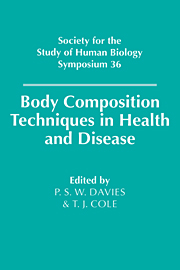Book contents
- Frontmatter
- Contents
- List of contributors
- 1 Application of dual-energy X-ray absorptiometry and related techniques to the assessment of bone and body composition
- 2 In vivo neutron activation analysis: past, present and future
- 3 Magnetic resonance imaging for the assessment of body composition
- 4 Multi-frequency impedance as a measure of body water compartments
- 5 Body composition assessed by electrical conductivity methods
- 6 Body composition in malnutrition
- 7 Influence of body composition on protein and energy requirements: some new insights
- 8 Prediction of adult body composition from infant and child measurements
- 9 Assessment of body composition in the obese
- 10 The role of body physique assessment in sports science
- 11 The assessment of the body composition of populations
- 12 Changes in approach to the measurement of body composition
- 13 Multi-compartment models for the assessment of body composition in health and disease
- 14 The future of body composition research
- Index
10 - The role of body physique assessment in sports science
Published online by Cambridge University Press: 18 September 2009
- Frontmatter
- Contents
- List of contributors
- 1 Application of dual-energy X-ray absorptiometry and related techniques to the assessment of bone and body composition
- 2 In vivo neutron activation analysis: past, present and future
- 3 Magnetic resonance imaging for the assessment of body composition
- 4 Multi-frequency impedance as a measure of body water compartments
- 5 Body composition assessed by electrical conductivity methods
- 6 Body composition in malnutrition
- 7 Influence of body composition on protein and energy requirements: some new insights
- 8 Prediction of adult body composition from infant and child measurements
- 9 Assessment of body composition in the obese
- 10 The role of body physique assessment in sports science
- 11 The assessment of the body composition of populations
- 12 Changes in approach to the measurement of body composition
- 13 Multi-compartment models for the assessment of body composition in health and disease
- 14 The future of body composition research
- Index
Summary
Introduction
Physique is comprised of three distinct, yet interrelated components, namely, body size, structure and composition (Boileau & Lohman, 1977). The elements of physique thus defined have been adopted for this text. Body size refers to the physical magnitude of the body and its segments (e.g. length, mass, volume, surface area). Body structure alludes to the distribution or body parts expressed as ratios (e.g. inverse ponderal index). Body composition adverts to the amount of the various constituents in the body (e.g. fat, water, mineral, protein).
Interest in the influence of body physique on physical performance dates back to antiquity (Gunther, 1975). Contrast the physique of a sumo wrestler with that of a marathon runner, or the physique of a volleyball player with that of a gymnast. Two striking observations become immediately apparent. Within a particular sport and position, the physiques of elite athletes appear similar. In contrast, body size, structure and composition differ markedly among athletes of different sports.
Why is the assessment of physique important? The assessment of physique can be used to ascertain an individual's readiness for sport participation in terms of injury prevention. A chemically immature skeleton is less able to withstand the trauma and shearing stresses incurred in contact sports (e.g. football) or in sports with repeated internal trauma (e.g. long distance running, pitching) than a mature skeleton, thus rendering the athlete more prone to fractures and avulsions. The assessment of physique can also be utilised to characterise the profiles of athletes in different sports. An individual with a particular profile can be encouraged to participate in the sport for which he or she is physically best suited.
- Type
- Chapter
- Information
- Body Composition Techniques in Health and Disease , pp. 166 - 194Publisher: Cambridge University PressPrint publication year: 1995
- 5
- Cited by



